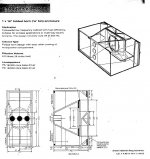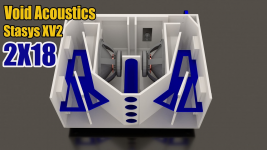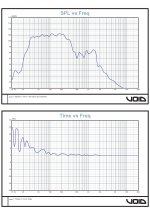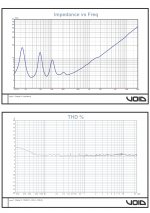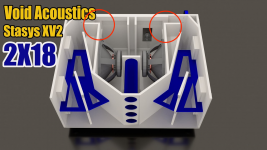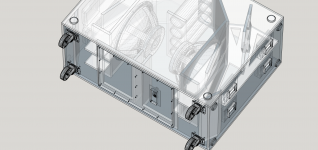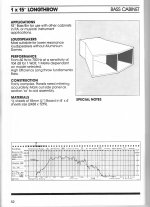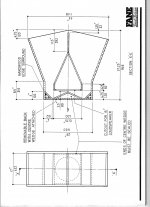While I can imagine that it sounds nice I am having difficulties to believe the LF frequency respose specification.
Hmm, its acoustically large footprint got me down to ~32.5 Hz/2pi in a quick 'ballpark' calc, so combined with 'only' a published ~94.21 dB eff. w/DSP it seems reasonable that an internally vented compression horn could reach an 18 Hz/F3 baseline in room or even in the open depending on how much loading the sides, tapered rear adds to the total baffle/mirror area.
I built 8 x 15" for PA use about 25 years ago, based on a discussion I had with the late Steve Hewlett of Fane Acoustics, the Void Stasys X V2 is also of a similar design principle. I posted the concept on another forum about 12 years ago, somehow Klipsch still managed to get a patent on it.
Funny you mention Fane and Void, because I considered attaching some pictures of both. So, here they are.
Plots are from the Stasys X, the previous model.

Attachments
Last edited:
That's a pretty impressive response. It must suffer somewhere my guess is it has a crazy Spectral Decay chart.
I think I'm looking at a w-bin 4' wide x 3' deep x 2' tall.
7-8ft2 mouth, maybe 5' horn length, on the floor is not really 2pi unless the mouth is literally exiting to the middle of a concrete floor, so i'd want a stimulator to acount for that, and i prefer a horn length to be 1/2 octave lower than mouth, so if you want 100hz, I'd try for 1/4 wavelength of 75hz (3.75'). So id estimate it could do for 75hz horn.
You can see most horn subs roll below 100hz when tested out in parking lots.
And i can post graphs where horn subs dont coupke well, +6db at 200hz for 4 horn subs, zero coupling of 4 horn subs at 30hz, but at least you can share eq spread over 4 subs instead of one.
I love w-bins, serious slam, not much bass near it, but much more 10' away (need to be greater than 1/4 wavelength, even bruce edgar attested to that).
7-8ft2 mouth, maybe 5' horn length, on the floor is not really 2pi unless the mouth is literally exiting to the middle of a concrete floor, so i'd want a stimulator to acount for that, and i prefer a horn length to be 1/2 octave lower than mouth, so if you want 100hz, I'd try for 1/4 wavelength of 75hz (3.75'). So id estimate it could do for 75hz horn.
You can see most horn subs roll below 100hz when tested out in parking lots.
And i can post graphs where horn subs dont coupke well, +6db at 200hz for 4 horn subs, zero coupling of 4 horn subs at 30hz, but at least you can share eq spread over 4 subs instead of one.
I love w-bins, serious slam, not much bass near it, but much more 10' away (need to be greater than 1/4 wavelength, even bruce edgar attested to that).
Last edited:
Why didn't they either physically connect the driver magnets to cancel forces or turn one around and cancel 2nd's...
//
//
Why didn't ....... or turn one around and cancel 2nd's...
Because it is a double horn needing two equal compression chambers. Reducing k2 caused by the drivers could even be useless with a horn.
The holes in the back could indeed be reflex ports feeding the horn like in the Klipsch.
Regards
Charles
Thank you, Ro808. I don't know if this is a common design nor what it is commonly called, but it would be a good thing as far as I can tell from the response and from the good reputation of VOID.
Comments of Rog Mogale, the owner Void:
"The Stasys X is 102dB at 30Hz and 103dB at 31.5Hz.
The specs, which have to be updated, state -3dB at 34Hz, but that was for a prototype which got changed at the last moment. All production models are -3dB at 30Hz.
Really it's just a double 18" reflex cab with front loaded drivers. There is a clever cloaking device that makes it look like there are ports and horns.
The port tuning at horn cutoff is about 28Hz for the port and about 57Hz for the horn. The pivotal point of the whole design is 50Hz. You can see something going on at 50Hz in all the plots. It's the point where the ports output meets or takes over from the horns cutoff point. There is a small dip in the THD plot, a peak in impedance and a dip in GD.
The port output isn't as loud as the horns output. The frequency plot really gives away what is happening here. Above 60Hz the response averages 105dB with 106.5dB peaks. The plot shows a typical horn response of peaks and undulations. Below 60Hz the response smooths out. This is typical of the output from a port. Its also at an average of 103.5dB, so it's not as loud as the horns output. Any port has losses, the longer the port the greater the losses due to there being a greater wall surface area. If you take a 4.5 meter port with its considerable losses and now make it only 45 cm long, you will have less losses and more output. Of course the new shorter port can never have the same tuning frequency as one that's 10 times longer, or can it, ha ha.
The peaks in the impedance plot are undamped areas, so the port/horn tuning lies at the lowest point between peaks. The highest small peak is due to a harmonic of one of the chambers resonances. Looking at the Z plot it's quite an easy cab to drive, this is born out in reality as well.
The ultimate bass bin is the size of a small briefcase, weighs 3Kg has no moving parts and can do 140dB at 10Hz. Stasys X is quite a long way off from that, but I do think that Stasys X is at the edge of what can ever be achieved from its volume. There's no getting away from Hoffmans Iron Law and with the materials and technology we have at this time I think Stasys X is making as best use of the space it occupies as anything ever will. It's got to the point where that's it, you will never get anymore out in terms of SPL or frequency response from its size enclosure. It doesn't matter who tries or what they try with it can only ever be matched. Give me a bigger enclosure or materials from 200 years in the future and it can have more output and play even lower. But for now its reached 100% effeiciency of what you can ever get from what we have.
The plots are ground plane made outside on a very large and flat concrete surface. The nearest boundary is over 20 meters away. This gives me accuracy down to 8.6Hz as its 20 meters from the DUT to the boundary and 20 meters back, making a round trip of 40 meters which is has a wavelength of 8.6Hz
Bigger ports are not louder than smaller ones, but ports with less losses are louder.
The loudest low sound I never heard was in a ship once. I was near the engine room in this narrow hallway. Don't know the frequency, but must have been 15 to 18Hz. So strange when you can't hear anything but you eyeballs are shaking.
My ears give up under about 26Hz. I can tell that it's a note down to about 26Hz, but below that it doesn't make sense and isn't really there."
"The Stasys X is 102dB at 30Hz and 103dB at 31.5Hz.
The specs, which have to be updated, state -3dB at 34Hz, but that was for a prototype which got changed at the last moment. All production models are -3dB at 30Hz.
Really it's just a double 18" reflex cab with front loaded drivers. There is a clever cloaking device that makes it look like there are ports and horns.
The port tuning at horn cutoff is about 28Hz for the port and about 57Hz for the horn. The pivotal point of the whole design is 50Hz. You can see something going on at 50Hz in all the plots. It's the point where the ports output meets or takes over from the horns cutoff point. There is a small dip in the THD plot, a peak in impedance and a dip in GD.
The port output isn't as loud as the horns output. The frequency plot really gives away what is happening here. Above 60Hz the response averages 105dB with 106.5dB peaks. The plot shows a typical horn response of peaks and undulations. Below 60Hz the response smooths out. This is typical of the output from a port. Its also at an average of 103.5dB, so it's not as loud as the horns output. Any port has losses, the longer the port the greater the losses due to there being a greater wall surface area. If you take a 4.5 meter port with its considerable losses and now make it only 45 cm long, you will have less losses and more output. Of course the new shorter port can never have the same tuning frequency as one that's 10 times longer, or can it, ha ha.
The peaks in the impedance plot are undamped areas, so the port/horn tuning lies at the lowest point between peaks. The highest small peak is due to a harmonic of one of the chambers resonances. Looking at the Z plot it's quite an easy cab to drive, this is born out in reality as well.
The ultimate bass bin is the size of a small briefcase, weighs 3Kg has no moving parts and can do 140dB at 10Hz. Stasys X is quite a long way off from that, but I do think that Stasys X is at the edge of what can ever be achieved from its volume. There's no getting away from Hoffmans Iron Law and with the materials and technology we have at this time I think Stasys X is making as best use of the space it occupies as anything ever will. It's got to the point where that's it, you will never get anymore out in terms of SPL or frequency response from its size enclosure. It doesn't matter who tries or what they try with it can only ever be matched. Give me a bigger enclosure or materials from 200 years in the future and it can have more output and play even lower. But for now its reached 100% effeiciency of what you can ever get from what we have.
The plots are ground plane made outside on a very large and flat concrete surface. The nearest boundary is over 20 meters away. This gives me accuracy down to 8.6Hz as its 20 meters from the DUT to the boundary and 20 meters back, making a round trip of 40 meters which is has a wavelength of 8.6Hz
Bigger ports are not louder than smaller ones, but ports with less losses are louder.
The loudest low sound I never heard was in a ship once. I was near the engine room in this narrow hallway. Don't know the frequency, but must have been 15 to 18Hz. So strange when you can't hear anything but you eyeballs are shaking.
My ears give up under about 26Hz. I can tell that it's a note down to about 26Hz, but below that it doesn't make sense and isn't really there."
Last edited:
The original version of the Stasys X had multiple rear chambers interconnected with ports (series tuned rear chambers?) IIRC, the version 2 has a very different internal layout and is ported into the throat whilst maintaining the same (or similar) external dimension / port layout so look the same.
The V1 also used heatsinks for driver cooling as the drivers were buried in the the cab and had no direct airflow to the outside, I remember reading somewhere that the V2 improved transient response and cooling over the V1.
I have yet to see plots for the V2, only seen the plots for the V1 so far have not had a chance to listen to either of them.
The inspiration for mine was originally Steve's story of being asked to go over to a nightclub in Belgium to see what could be done to increase the low bass from a pile of Fane Handbook design 115 horns that were similar to the Martin 115, he ported them on the driver baffle in the throat and had a very happy customer. As I had a couple of Martin 115's and some Colossus XB's, I ported them and sure enough the weight of the bass increased substantially, with some eq, the whole workshop was alive and they could take a load more power in the lows before crapping out for only a small softening of the punch the 115's are famous for.
I do like mine, not as refined as Rog's, will hopefully revisit the design again, they make for a very versatile wideband bass cab.
The V1 also used heatsinks for driver cooling as the drivers were buried in the the cab and had no direct airflow to the outside, I remember reading somewhere that the V2 improved transient response and cooling over the V1.
I have yet to see plots for the V2, only seen the plots for the V1 so far have not had a chance to listen to either of them.
The inspiration for mine was originally Steve's story of being asked to go over to a nightclub in Belgium to see what could be done to increase the low bass from a pile of Fane Handbook design 115 horns that were similar to the Martin 115, he ported them on the driver baffle in the throat and had a very happy customer. As I had a couple of Martin 115's and some Colossus XB's, I ported them and sure enough the weight of the bass increased substantially, with some eq, the whole workshop was alive and they could take a load more power in the lows before crapping out for only a small softening of the punch the 115's are famous for.
I do like mine, not as refined as Rog's, will hopefully revisit the design again, they make for a very versatile wideband bass cab.
Yes, from the Fane design book. The cabs I built are my own design, those are a pig to transport.
Because it is a double horn needing two equal compression chambers. Reducing k2 caused by the drivers could even be useless with a horn.
The holes in the back could indeed be reflex ports feeding the horn like in the Klipsch.
Regards
Charles
Canceling forces should be doable with separate chambers.
//
I would say that there are tons of combinations of horn/bandpass/reflex loading with different properties.
If transport capabilities and space are not constrained an old school straight horn is probably still the best.
IIRC the original Martin bin had a lower horn constant (i.e. was opening less fast) than the Fane example. Maybe that was due to copyright issues.
Regards
Charles
If transport capabilities and space are not constrained an old school straight horn is probably still the best.
IIRC the original Martin bin had a lower horn constant (i.e. was opening less fast) than the Fane example. Maybe that was due to copyright issues.
Regards
Charles
Canceling forces should be doable with separate chambers.
I was talking about the compression chamber right at the horn thoat. It is veeeeery difficult to build a small cpompression chamber when loading the back of a driver. And you would only cancel out even order distortion. And I would say that the driver's even order distortion is probably lower than the horn's intrinsic even order distortion due to the non-ideal behaviour of the air.
Regards
Charles
- Home
- Loudspeakers
- Multi-Way
- Is it possible to cover the whole spectrum, high SPL, low distortion with a 2-way?
